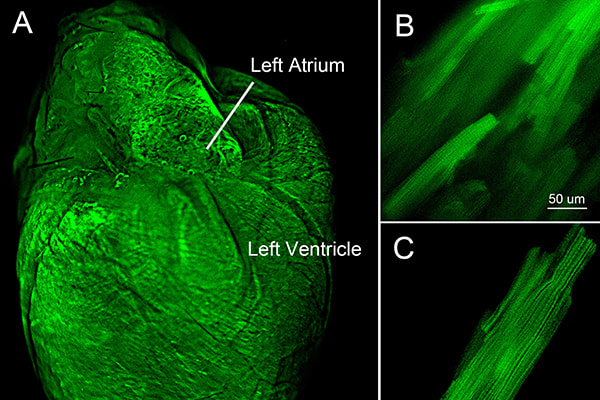Heart’s electrical propagation focus of WashU interdisciplinary study
An interdisciplinary team will study the molecular functioning behind regulation of the heart

The heart relies on electrical signals generated by ion channel proteins to tell it when to expand and contract. Genetic mutations in the genes that encode ion channel proteins, as well as changes in the expression of properties of these proteins that alter ion channel function, expose patients to various problems, from an irregular heartbeat to sudden cardiac death.
An interdisciplinary team from Washington University in St. Louis will investigate a novel protein component of the cardiac sodium channels to determine its functional effects in the physiological regulation and pathophysiological remodeling of electrical propagation of the heart.
Jeanne Nerbonne, the Alumni Endowed Professor of Molecular Biology and Pharmacology in Developmental Biology and Internal Medicine and director of the Center for Cardiovascular Research at the School of Medicine, and Jonathan Silva, associate professor of biomedical engineering in the McKelvey School of Engineering, are teaming up to study intracellular fibroblast growth factor 12 (iFGF12), a novel sodium channel accessory protein, with a four-year, $2.3 million grant from the National Institutes of Health's National Heart, Lung, and Blood Institute. The research will combine Nerbonne's expertise in studying the molecular underpinnings of ion channels in mouse and human hearts with Silva's expertise in analyzing the nanoscale biophysics of cardiac sodium channels and describing them with computational models. Together, they seek to determine the regulatory effects of iFGF12B, the variant expressed in nondiseased human hearts, and the distinct functional effects of the iFGF12A variant, which is upregulated in a failing human hearts, to gain mechanistic insights to drive precision medicine.
"We know from previous studies that native cardiac sodium channels function in macromolecular protein complexes comprising the pore-forming sodium channel protein and multiple intracellular and transmembrane accessory proteins that regulate channel expression and properties," Nerbonne said. "We also know, from previous work in expression systems and in the nervous system, that accessory iFGF proteins influence the biophysical properties of sodium channels, such as how they open and how they close. We will determine how iFGF12B and iFGF12A regulate the biophysical and the pharmacological properties of cardiac sodium channels and whether they influence the functional effects of other sodium channel accessory proteins."
"This study is an exciting opportunity to start thinking about how different accessory subunits interact with the channel, regulate it and affect the ability of the channel to respond to different drug therapies," Silva said. "In addition, the experimental data will allow us to develop detailed computational models of cardiac sodium channels and the modulatory effects of iFGF12 and other accessory proteins on these channels. There are a lot of different factors coming together, and connecting the nanoscale data to whole cell and whole heart functioning is not intuitive," Silva said. "The approaches used by our two labs are synergistic, and we think this will take us further because we are working together at different scales."
"The plan is that the experimental and modeling efforts will go back and forth to inform each other," Nerbonne said. "We'll do experiments and use the acquired data to refine the models. The models will make predictions of what is expected to happen to channel, whole cell and whole heart functioning under different conditions. Then, we'll go back to design and complete new experiments to test these predictions."
Washington University School of Medicine's 1,500 faculty physicians also are the medical staff of Barnes-Jewish and St. Louis Children's hospitals. The School of Medicine is a leader in medical research, teaching and patient care, ranking among the top 10 medical schools in the nation by U.S. News & World Report. Through its affiliations with Barnes-Jewish and St. Louis Children's hospitals, the School of Medicine is linked to BJC HealthCare.





